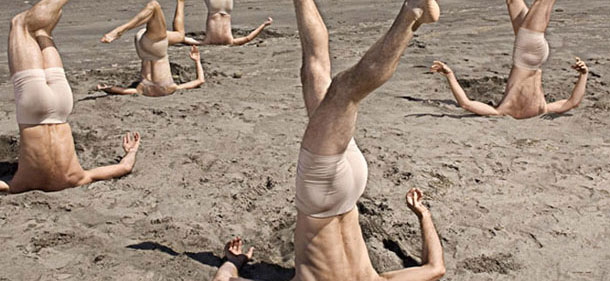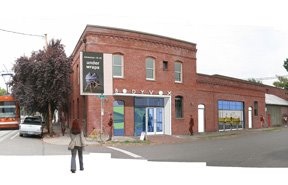
BodyVox’s “Water Bodies,” which helped inaugurate the new dance center (minus the sand!) and is going on the road. Photo: J. Dunham Carter, Polara Studios
The downside of BodyVox’s ambitious move into its own new BodyVox Dance Center in Northwest Portland?
Jamey Hampton, co-artistic director with his wife, Ashley Roland, of the Portland-based touring dance and movement ensemble, paused to consider the question.
“We were closer to cold beer before,” he finally allowed.
 Surely a heavy price to pay — and the pizza was good, too. For several years BodyVox kept house in sunny but cramped quarters on the top floor of the BridgePort Brewpub, several blocks away from the company’s new digs at Northwest 17th Avenue and Northrup Street.
Surely a heavy price to pay — and the pizza was good, too. For several years BodyVox kept house in sunny but cramped quarters on the top floor of the BridgePort Brewpub, several blocks away from the company’s new digs at Northwest 17th Avenue and Northrup Street.
But as charming as the proximity was, it’s tough to think of many other drawbacks to the move, which gives BodyVox a much bigger and more sophisticated space that also has the potential to be a vital community resource. As general manager Una Loughran put it, “We want this space to be used.”
One evening late last week BodyVox threw a little open house-slash-open rehearsal to show off the new space, and everyone was pretty much in a celebratory mood. Beer (BridgePort, of course) and wine were flying out of the lobby. Bodies were flying just as rapidly around the new stage, which is 60 feet wide as opposed to 40 in the old space, a huge difference in terms of choreographic possibility.
The rehearsal was mostly for Water Bodies, which the company is taking on tour to Philadelphia and New York state in mid-October (the home season, which will be performed entirely in the new space, opens Nov. 12), and with a crowd on hand it was loose. Christopher Stowell, artistic director of Oregon Ballet Theatre, stood at the side of the stage with a microphone to talk about what was going on in the dances, and when Hampton and Roland weren’t out on the stage performing, they joined in on the chat, too.
I talked briefly with veteran dancer Eric Skinner, one of BodyVox’s artistic anchors. He and the company were getting ready for a quick trip to Minnesota for a performance tomorrow night (Sept. 24) at College of St. Benedict and St. John’s University near St. Cloud. I congratulated him on the company’s wisdom in scheduling a trip to the upper Midwest in September instead of January.
Eric grinned. “Coldest winter I ever spent was the year I danced with Milwaukee Ballet,” he said.
By the time everything’s finished BodyVox’s main performing space will hold 160 seats, up from 90 in the old space. “It really transforms the financial picture for us,” Loughran said.
A front studio with big inviting garage-door windows onto the street was in use during the reception and already is attracting dancers for lots of classes. “That’s nice, too. Gets us back to that revenue flow,” said Loughran, whose job it is to worry about such things.
Not that anything was guaranteed, especially financially.
Way back yonder in the olden days (it was September 9, 2008) I posted this little report about BodyVox and my visit to its newly acquired space. (Roland and Hampton actually own the building, Loughran said, and lease it back to the dance company on “incredibly generous” terms.) Back then the old brick building was pretty much an empty space, with cool drawings by BOORA architects of what it would eventually look like.
The dance center began life as Portland’s Wells Fargo headquarters. That’s Wells Fargo as is long-range delivery company, not Wells Fargo as in bank: carriage storage, stables, a dormitory for the drivers. It was also home for a few years in the early 1960s to the old Portland Reporter, the union newspaper that sprang up during the fierce strikes that shook the morning Oregonian and afternoon Oregon Journal and led to the ousting of unions from both papers.
The purchase wasn’t without risk — and then things turned harrowing. Right about then the already wobbly American economy fainted dead away into this infernal recession/depression, which you could call a decession, or, as I tend to think of it, a repression. And what with construction projects all across America being postponed or halted in mid-dig, I wouldn’t have been surprised if that had been that: Who was going to put money into a dance center when the economic sky was falling in?
 Turns out, it slowed things down but didn’t stop them. The BodyVox rehab project has been broken into three phases, and the physical move into the dance center marked the completion of Phase I. Loughran says the refurbishment cost so far has been about $500,000 of an eventual $900,000. (The entire project, including purchase of the building from longtime arts supporter Henry Hillman, is pegged at $3.2 million.)
Turns out, it slowed things down but didn’t stop them. The BodyVox rehab project has been broken into three phases, and the physical move into the dance center marked the completion of Phase I. Loughran says the refurbishment cost so far has been about $500,000 of an eventual $900,000. (The entire project, including purchase of the building from longtime arts supporter Henry Hillman, is pegged at $3.2 million.)
A lot of smart recycling has gone into the rehab. Beautiful century-old wood torn out of the old mezzanine level, for instance, now accents the handsome lobby. Better stage lighting, audience risers and more seismic upgrading are among the things still to come.
Hampton thinks the move has energized the dancers and maybe even nudged them to a new level. “The moving into the new space seems to be a transformational event for our company,” he said.
Transformational or not, it was clearly a lot of fun during the open house, which was one of those rare relaxed times when an audience gets an inside peek into the creative workings of a performance troupe.
Roland talked about the challenges of choreographing a piece when you’re going to be dancing in it yourself. The two tasks engage very different “brain sets,” she said (choreography wide and encompassing, dancing narrow and focused), and need to be approached discretely: “After you choreograph it, you have to learn it.”
Hampton talked about the big emptiness from which art springs — “All dance concerts start from nothing. They start from zero” — and marveled at the elegance and effectiveness of a single well-placed balletic movement: “It’s easier to do something big and pantomimey. It’s harder to do a very simple step.”
It was good to revisit some of these pieces. Kaleidoscope, which Roland and Hampton choreographed to John Adams‘ music Standchen, is just like seeing human bodies through a kaleidoscope (or maybe in a Busby Berkeley spectacle) — those fractured spokes of images, with perfect mathematical echoes. It’s what happens when chaos encounters logic. And for some reason in Adams’ churning, carney-fairground, very American-sounding music I heard echoes of Charles Ives.
BodyVox is known for its optimism and its quirky humor, and both were in full display in The Big Dip, a sort of ode to social dance from swing to sampling to hip hop, with even a little Charleston tossed in. “We sort of had to abandon technique” to choreograph this one, Hampton said wryly. The music, by Sex Mob, is a hilarious, jangly twist of big-band bounce that moves like a runaway freight train through a meadow of magic mushrooms.
But BodyVox can also do immensely moving work, as in S.O.S, which Hampton says began with the image of “a shipwreck and a group of people entering to usher the casualties from this life to the next life.” The movement, to Sibelius‘s Valse Triste and the hymn Nearer My God to Thee, is round and haunting and transformingly lovely.
The stereotype of artists is that they’re impractical, loosey-goosey types, nice to have around for choosing the wallpaper or pumping up the sales staff but incapable of making hard-headed decisions about Things That Really Matter. In fact, most artists run small businesses, and most arts groups operate very close to the bone, getting the most out of the least. Art is provisional, and the necessity of making quick decisions in the face of daunting circumstances is the essence of an extremely practical and efficient kind of creativity.
“We have had injuries in the first act” of a performance, Hampton said. “And spent intermission re-choreographing the second act. And it’s 20 minutes long. The intermission.”
What’s more, he added, it works better if you don’t talk about the changes, but let your bodies sort it out: You can redo 25 minutes of dancing in seven quick minutes, and still have time for a breather before the curtain goes up again. “Dancers have this kind of intelligence in their bodies,” he said.
Brains in their feet, brains in their hands, brains in their heads. No wonder this dance center deal came through in the midst of the repression. Wall Street could use some smarts like that.